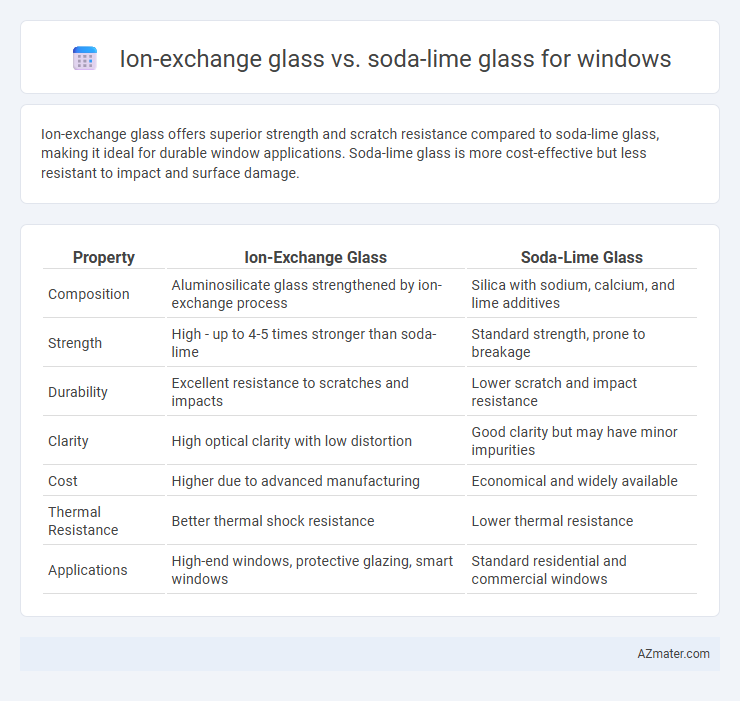Ion-exchange glass offers superior strength and scratch resistance compared to soda-lime glass, making it ideal for durable window applications. Soda-lime glass is more cost-effective but less resistant to impact and surface damage.
Table of Comparison
| Property | Ion-Exchange Glass | Soda-Lime Glass |
|---|---|---|
| Composition | Aluminosilicate glass strengthened by ion-exchange process | Silica with sodium, calcium, and lime additives |
| Strength | High - up to 4-5 times stronger than soda-lime | Standard strength, prone to breakage |
| Durability | Excellent resistance to scratches and impacts | Lower scratch and impact resistance |
| Clarity | High optical clarity with low distortion | Good clarity but may have minor impurities |
| Cost | Higher due to advanced manufacturing | Economical and widely available |
| Thermal Resistance | Better thermal shock resistance | Lower thermal resistance |
| Applications | High-end windows, protective glazing, smart windows | Standard residential and commercial windows |
Introduction to Window Glass Types
Ion-exchange glass offers enhanced strength and resistance to impact compared to soda-lime glass, making it ideal for windows requiring durability and safety. Soda-lime glass remains the most common window glass type due to its cost-effectiveness and ease of manufacturing, suitable for standard residential and commercial applications. Understanding the distinct properties of ion-exchange and soda-lime glass helps in selecting the best window glass type based on performance needs and budget constraints.
What is Ion-Exchange Glass?
Ion-exchange glass is a chemically strengthened glass created by replacing smaller sodium ions in the glass surface with larger potassium ions through a high-temperature salt bath process, resulting in a durable compressive stress layer that enhances strength and resistance to scratches. This glass is often used in windows due to its superior toughness and improved safety features compared to traditional soda-lime glass, which is composed mainly of silica, sodium oxide, and calcium oxide without undergoing a chemical strengthening process. Ion-exchange glass offers enhanced durability, making it ideal for energy-efficient, high-performance windows that require greater resistance to impact and environmental wear.
Overview of Soda-Lime Glass
Soda-lime glass is the most common type of glass used for windows due to its affordability, ease of manufacture, and satisfactory optical clarity. Composed primarily of silica, soda ash, and lime, this glass offers moderate strength and durability but lacks the enhanced surface hardness and resistance to impact found in ion-exchange glass. Its widespread use in residential and commercial windows is driven by cost-effectiveness and adequate performance in standard environmental conditions.
Strength and Durability Comparison
Ion-exchange glass offers superior strength compared to soda-lime glass, with a surface compression layer that significantly enhances impact resistance and scratch durability. Soda-lime glass, while more economical, has a lower tensile strength and is prone to scratches and breakage under stress, making it less suitable for high-impact environments. The ion-exchange process also improves resistance to thermal stress and extends the lifespan of windows in demanding conditions, ensuring greater overall durability.
Optical Properties and Clarity
Ion-exchange glass offers superior optical properties and enhanced clarity compared to soda-lime glass due to its chemically strengthened surface, which reduces micro-distortions and maintains uniform light transmission. This type of glass exhibits lower haze and higher transmittance, resulting in clearer, more vibrant views through windows. Soda-lime glass, while cost-effective, typically shows more optical imperfections and light scattering, leading to reduced clarity and potential distortion in window applications.
Thermal Performance Differences
Ion-exchange glass exhibits superior thermal performance compared to soda-lime glass due to its enhanced strength and resistance to thermal stress, allowing it to better withstand rapid temperature changes without cracking. Its increased surface compressive stress improves insulation properties, reducing heat transfer and enhancing energy efficiency in window applications. In contrast, soda-lime glass is more prone to thermal shock and has higher thermal conductivity, resulting in less effective insulation and greater heat loss.
Safety and Security Aspects
Ion-exchange glass offers superior safety by enhancing surface strength through a chemical tempering process that compresses the glass surface, significantly reducing the risk of breakage compared to soda-lime glass. In the event of breakage, ion-exchange glass tends to shatter into small, blunt fragments, minimizing injury risk, whereas soda-lime glass breaks into sharp, dangerous shards. Enhanced resistance to impact and stress makes ion-exchange glass a preferred choice for secure, durable windows in residential and commercial applications.
Cost and Availability
Ion-exchange glass offers enhanced strength and durability but comes at a significantly higher cost compared to soda-lime glass, which is more affordable and widely available. Soda-lime glass dominates the market due to its abundant raw materials and established manufacturing processes, making it the preferred choice for standard window applications. The higher production complexity and specialized equipment required for ion-exchange glass limit its availability primarily to premium or security-focused window installations.
Environmental Impact and Sustainability
Ion-exchange glass offers a more sustainable choice for windows due to its enhanced durability, reducing replacement frequency and waste compared to soda-lime glass. The ion-exchange process involves fewer raw materials and produces lower emissions, contributing to a smaller carbon footprint over the product lifecycle. Soda-lime glass, while cheaper and widely recycled, requires more energy-intensive manufacturing and often lacks the longevity benefits necessary for minimizing environmental impact in sustainable building designs.
Best Applications for Each Glass Type
Ion-exchange glass offers superior strength and durability, making it ideal for high-impact environments such as commercial buildings, earthquake-prone regions, and safety-critical applications like schools and hospitals. Soda-lime glass, being cost-effective and easy to manufacture, suits standard residential windows and low-stress architectural uses where budget constraints are a priority. The choice between the two hinges on balancing safety requirements against cost efficiency and typical environmental demands.

Infographic: Ion-exchange glass vs Soda-lime glass for Window
 azmater.com
azmater.com